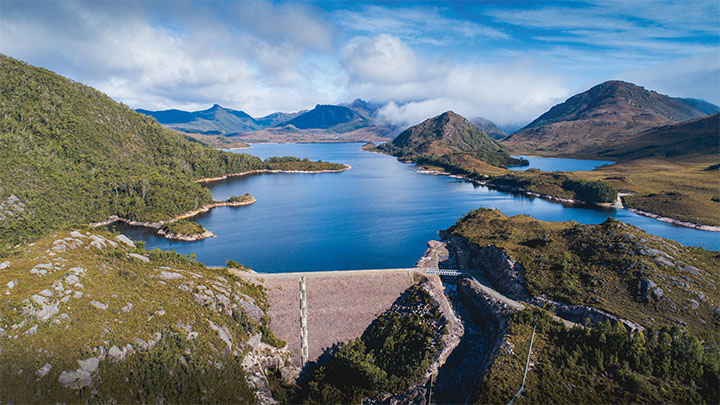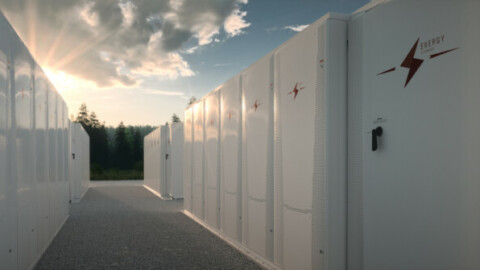Australia’s National Electricity Market (NEM) is undergoing a major transition, from dependence on fossil fuel, to predominantly using renewable energy. Accurately predicting what the future power system will look like is incredibly difficult, particularly in a time of rapid change. Yet it is clear that the variable generation renewables provide will need to be backed by sufficient flexible supply options (such as storage) to ensure the reliable electricity Australian customers expect.
This is where Hydro Tasmania’s Battery of the Nation project, and the deep storage opportunities it offers, comes in. The project is not a new one – it was first flagged in 2017, and has regularly formed a part of the national discussion regarding the changing energy market since then.
Battery of the Nation is about investigating and developing a pathway of future development opportunities in hydropower system expansion, including pumped hydro.
Tasmania has significant potential in the future development of wind and hydropower, coupled with more transmission and interconnection. Through Battery of the Nation, Tasmania could make a much greater contribution to the NEM, delivering more clean, reliable and affordable energy.
Tasmania is well placed to support the transition of the NEM, and has set a renewable energy target of producing 200 per cent of its current needs by 2040.
Tasmania’s naturally favourable topography and existing hydropower system provide an ideal opportunity to develop cost-effective deep storage pumped hydro that Australia needs to manage uncertainties and achieve a reliable future NEM.
What is deep storage – and why do we need it?
Deep storage is energy storage with the ability to operate over many hours as an optimal, least-cost choice, able to manage realistic uncertainty in the power system. It will play a critical role in efficiently supporting Australia’s energy transformation.
The Australian Energy Market Operator (AEMO) first started using the term “deep storage” in 2019, in discussions about the different sorts of storage requirements the market of the future would need.
“Up until recently storage was just storage, but the market planner last year started to point to big differences between what you might call shallow and deep storage,” said Christopher Gwynne, Battery of the Nation Project Director for Hydro Tasmania.
“Shallow storage essentially is storage that is four to six hours worth of storage in terms of its duration. Deep storage has a longer duration, in the range of ten to twelve hours.”
As the market transitions to having more input from renewable sources, these forms of short, or shallow storage, are the ones we need in place first – and they’re the ones we’re already starting to see on the market, in the form of projects like the Hornsdale battery in South Australia, and smaller, distributed batteries.
But according to Mr Gwynne, most of the analysis that’s going on around the world is showing that as markets move further into their transformations, longer, deeper storage options are required in order to maintain a stable and reliable power system.
“What this means is that by the mid to late ‘20s, we’re going to need some of these longer duration, deep storage assets to start to come into the market,” said Mr Gwynne.
“The value of this type of storage is in the fact that it’s better placed to manage longer term variations in supply, like what we might see during a wind drought, or a successive number of days of low solar output in the system.
“When dealing with these conditions, you’re going to need deep storage to help manage the reliability of the system.”
Potential sites and timelines
When it comes to the sites Hydro Tasmania is considering for hydro storage development as part of the Battery of the Nation initiative, Mr Gwynne is very clear on the fact that all sites under consideration need to have a clear linkage to the mainland.
In the case of Battery of the Nation, this is in the form of the concurrent Marinus Link, a proposed 1500MW capacity undersea electricity connection to link Tasmania and Victoria.
This project, proposed by TasNetworks, would be delivered in two stages – in the first stage, 750MW would come online around 2027, with another 750MW a year or two after that. Hydro Tasmania is looking to have a Battery of the Nation hydro site online to coincide with the launch of the second cable.
“The reason for this is because you have to remember that the whole existing hydropower system down here is like one big deep storage asset already – and it’s a deep storage asset that has excess capacity in it at the moment,” said Mr Gwynne.
What that means is that when the first Marinus Link cable is connected to the mainland, it will essentially be able to utilise the existing Tasmanian scheme to bring additional storage capacity to the Victorian market in particular.
“The reason why we can do that is because when that first cable is built, a lot of wind and solar development will be stimulated, not just in Tasmania, but most likely in Victoria as well,” said Mr Gwynne.
“So all of a sudden, Tasmania isn’t relying on our hydro systems to keep the lights on all of the time anymore – we’ll have new sources of supply that will be doing that. That then allows us to use the hydro system for storage, which is a much better use of that asset, rather than providing baseload energy all of the time.”
Hydro Tasmania is then looking at commissioning a pumped hydro site to come online when the second Marinus cable is connected.
“We’re currently looking at three sites, and each of these is in quite intensive feasibility assessment at the moment,” said Mr Gwynne. “We’ve got two in the northwest, one at Lake Cethana and one at Lake Rowallan. They’re both lakes that are in our existing hydropower scheme, we’re just going to be augmenting them to be able to manage a new pumped hydro station. The third site we’re looking at is on the west coast, in our existing system again, but essentially it’s right next to where we currently have a power station called Tribute. That site would effectively be connecting up to existing reservoirs we have in our scheme, and we’d be installing a new pumped hydro installation there.”
The next step for Mr Gwynne and his team is to narrow the three sites under feasibility down to one, which will happen over the next 12 to 18 months. Conveniently, this timing lines up with the Final Investment Decision on Marinus Link – so when the market makes its decision on this project, Hydro Tasmania will be ready to pull the trigger on their preferred site and commence construction.
Who still needs convincing?
Given the benefits Battery of the Nation has to offer, and the clear need we will have for deep storage as we transition to cleaner sources of energy, it does raise the question: who still needs to be convinced that this project will be a necessary part of our future energy system?
“One of the challenges that we’ve had with this project right from when I started, which was back in 2017, was that there was a really low level of awareness in the broader national market on how the Tasmanian power system worked, in particular the hydro system,” said Mr Gwynne.
“That’s not a criticism; it’s just the fact that no one really needed to know how it worked, because it was a separate system to the NEM.
“So when we started talking about the potential of pumped hydro development in Tasmania, many people assumed that the hydropower system in Tasmania worked like Snowy, and looked at it through that lens. However, they’re very different systems.”
According to Mr Gwynne, Snowy has never been used like baseload generation. It’s never had to keep the lights on 24/7, it’s been there to fill the gaps when other forms of generation weren’t able to do the job.
For Hydro Tasmania however, the job has always been quite different. Its job has been to keep the lights on, and because of this, it is a very different system to Snowy.
“Because these differences aren’t widely known, we do have a big task ahead to be able to get people to understand what the potential looks like down here, and why it should be a project that should figure in the market of the future,” said Mr Gwynne.
“We also need to keep talking about this project, and the benefits it will offer, is so people can understand the benefits that will come with the significant cost of building another interconnection between Tasmania and Victoria.
“Let’s not shy away from the fact that building another interconnector between Tasmania and Victoria is an expensive project. But if the market doesn’t understand the potential of the hydropower system in Tasmania, the idea of building an interconnector between Tasmania and Victoria seems almost absurd.
“It’s only when you understand the power of the hydro system that sits at the other end of the cable, and the potential for what it could do when we want to get some high levels of renewable energy penetration in the system, that’s when you start to understand the cost benefit analysis that would come for building another interconnector.”
According to Mr Gwynne, the conversations that are happening in the industry and the market about these two intertwined projects are critically important right now, as we start to take the first steps towards the renewable energy future we’ve long been talking about.
The future is uncertain and we need sound supply options
Key strategic decisions in coming years will shape the NEM for decades to come; and yet, the same factors that are prompting the critical infrastructure decisions are also the source of substantial uncertainty.
Increasing levels of low-cost wind and solar will result in increased need for flexible supply, such as storage, to maintain reliability.
Deep storage provides a robust plan for the future NEM. As the supply options in the power system become more variable, storage will need to play an increasingly important role.
Importantly, for over 100 years, Hydro Tasmania has managed the challenges of ensuring reliability in a power system dependent on weather-driven renewable energy. This provides a strong understanding of how longer storage duration supports more flexible operating choices.
Hydro Tasmania is very quick to point out that there is a role for all storage types in the energy market of the future. The role for deep, longer duration storages will be in maintaining system reliability. For the market we wish to have in the future, Battery of the Nation is of vital importance.


















